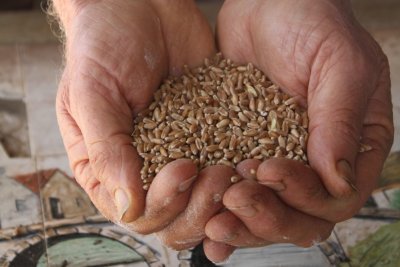Sustain / Real Bread Campaign / Articles
Freeze!
Barrie Lewis explains why a chest freezer is an essential bit of his South African home milling and baking setup.

Grain has three enemies; well, four if you include industrial millers who denude the grain of the best parts and might also be duplicitous about using the term ‘wholemeal.’ The others are air, moisture and the granary weevil. All four present challenges for people wanting to enjoy the nutritional benefits and wonderful flavour of wholemeal sourdough bread.
The first is the most difficult. You either have to find a miller who produces un-sifted stoneground flour, or genuinely recombines 100% of all streams from the roller milling process. Another option is to mill your own. Twenty-five years ago we bought a Hawos Oktagon 1 tabletop stone mill, which was expensive at the time but has since paid itself off many times over. It still faithfully grinds flour daily.
Giving weevils the cold shoulder
I do not want to buy grain that has been poisoned with chemicals like hydrogen phosphide gas, so the way I deal with flour weevils is by freezing. I buy a year’s supply of untreated wheat directly from a farm. A loaf a day means around 150kg of wheat per annum, though usually more because friends and family will be clamouring for my bread! I ask the farmer to ensure that the grain is completely dry; they have to do this in any case before sending to storage depots or it will be downgraded or rejected. I also ask that the grain is put through a coarse filter to get rid of the chaff and the worst of the dust from the fields.
The first step for storage is to place a large, heavy-duty plastic sack into a 25-litre plastic container. I fill each bag to the brim with wheat, tie it tightly with string (squishing out as much air as possible) and then fit the airtight lid. Initially we tried putting the bags straight in the deep freeze but they tended to tear, hence the containers. Finding food-grade buckets and heavy-duty plastic bags of this size was our biggest challenge. I don’t bother buying recycled plastic as we will re-use the bags and buckets many times. The buckets then go into a chest freezer. To ensure that any weevils and their eggs are killed, we freeze the wheat for at least two weeks on the coldest setting.
Keeping my (wheat) cool
It is vital to keep grain and flour dry to prevent the growth of mould and other fungi, some of which produce aflatoxins. These can cause liver damage and are potentially carcinogenic. Provided the wheat was properly dried by the farmer, there should be very little moisture in it. When the buckets come out of the deep freeze, though, the moisture in any air that’s able to enter the bucket or bag will condense, so needs to be kept out until the grain is up to ambient temperature. Properly treated wheat can then be stored in a cool, dry place almost indefinitely.
I sieve the wheat again prior to milling but accept there will still be bits and fish out the worst of them as I’m feeding the mill. It’s virtually impossible for the home miller to remove every last bit of chaff but I don’t think it’s necessary. A peck o’ dirt never did me much, if any, harm. As an aside, it bemuses me that some people are so concerned about the visible detractions in food, like a hole in a spinach leaf or a little chaff in flour, but have no worries about the presence of invisible ecocides.
Worth the effort
This process might seem intimidating to someone who just wants to bake a couple loaves of decent bread every week but for me it has been a most satisfying part of my Real Bread journey. A day in the country finding a farmer and bringing home bags of grain, then milling it to produce the most wonderful-tasting, true wholemeal, genuine sourdough bread. Just the scent as the wheat is being milled is divine, and completely lost to most of humanity. And this is all before considering the known and potential health benefits…
See also
Published Friday 19 July 2024
Real Bread Campaign: Finding and sharing ways to make bread better for us, our communities and planet.

